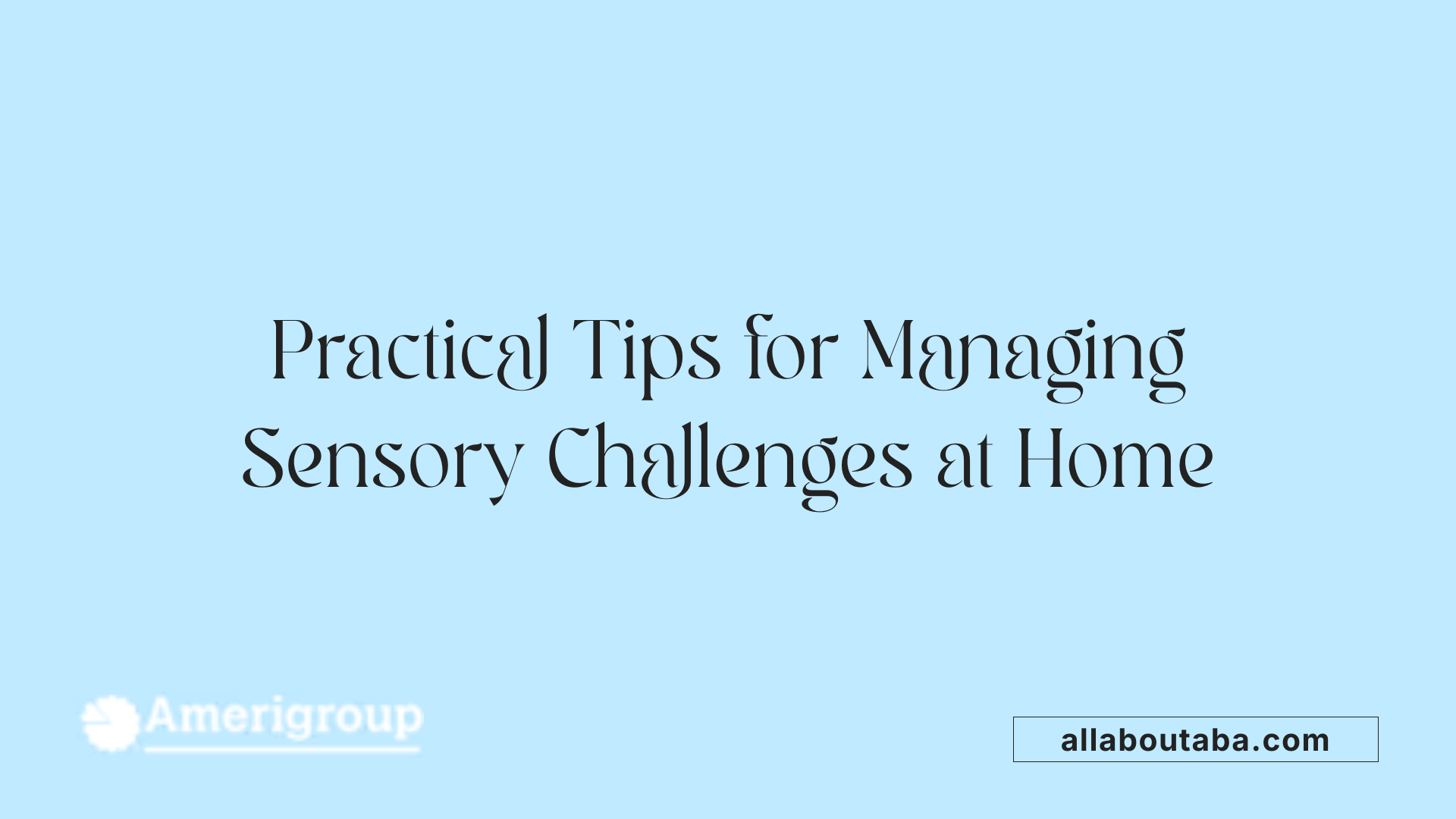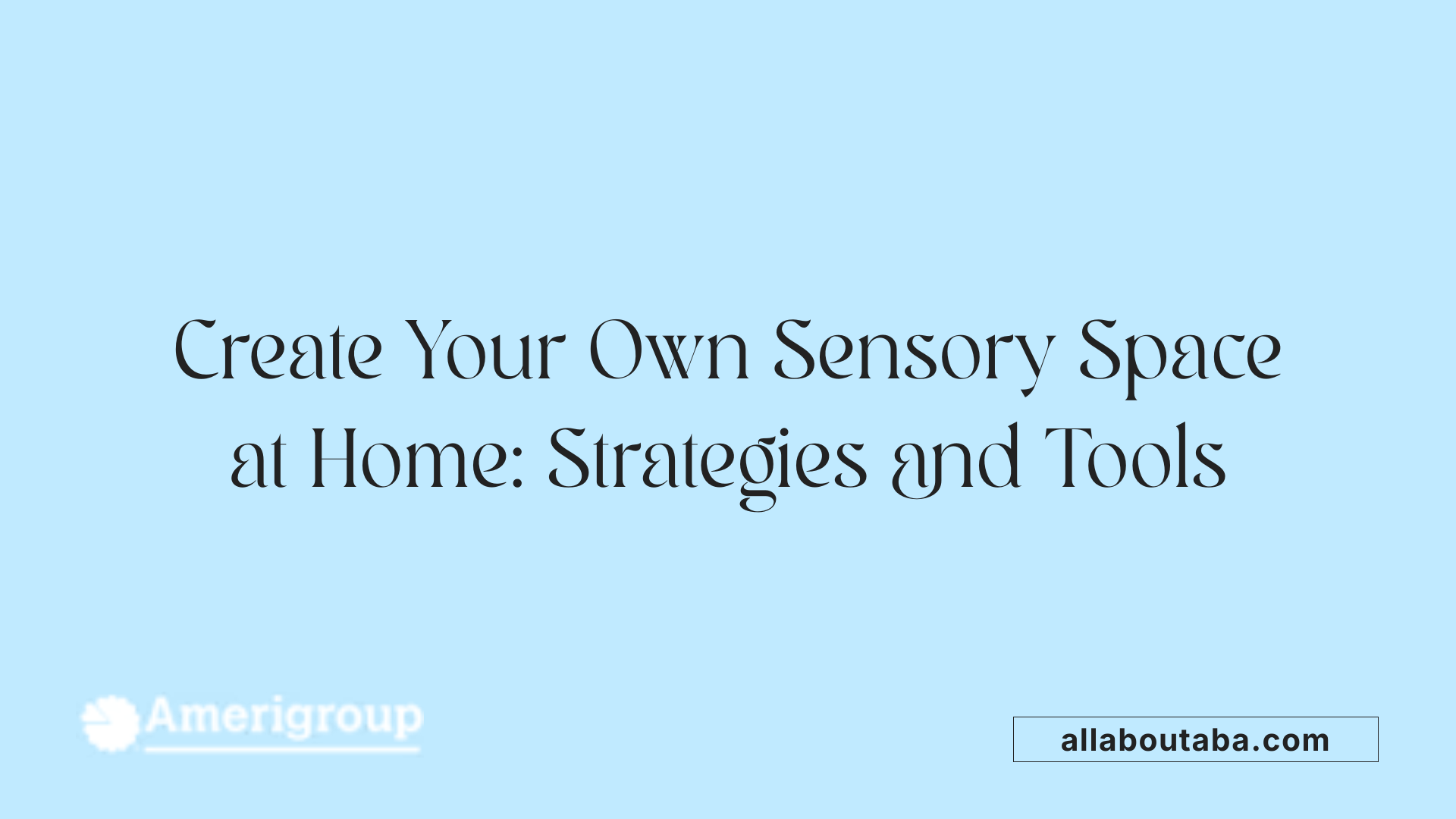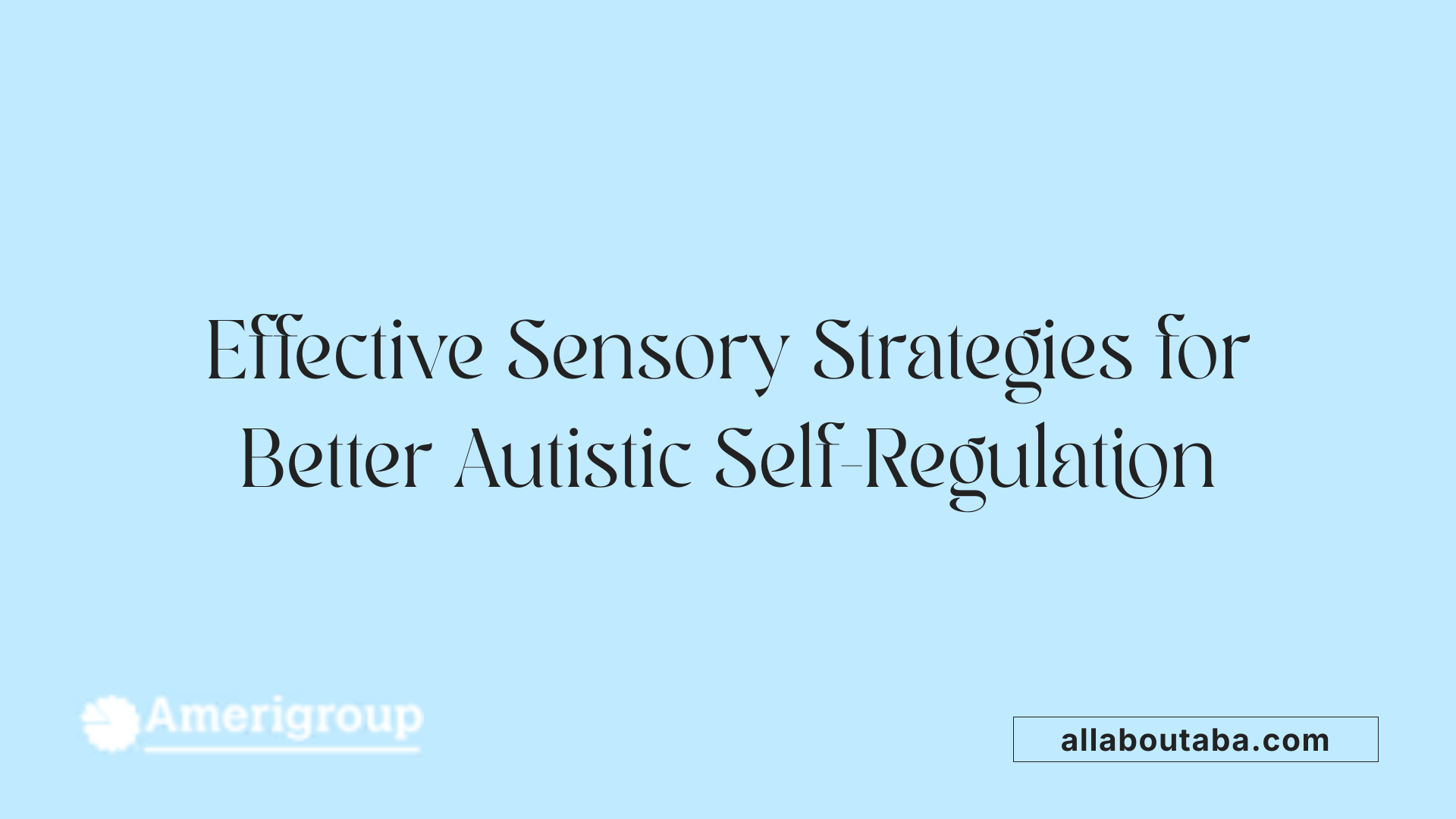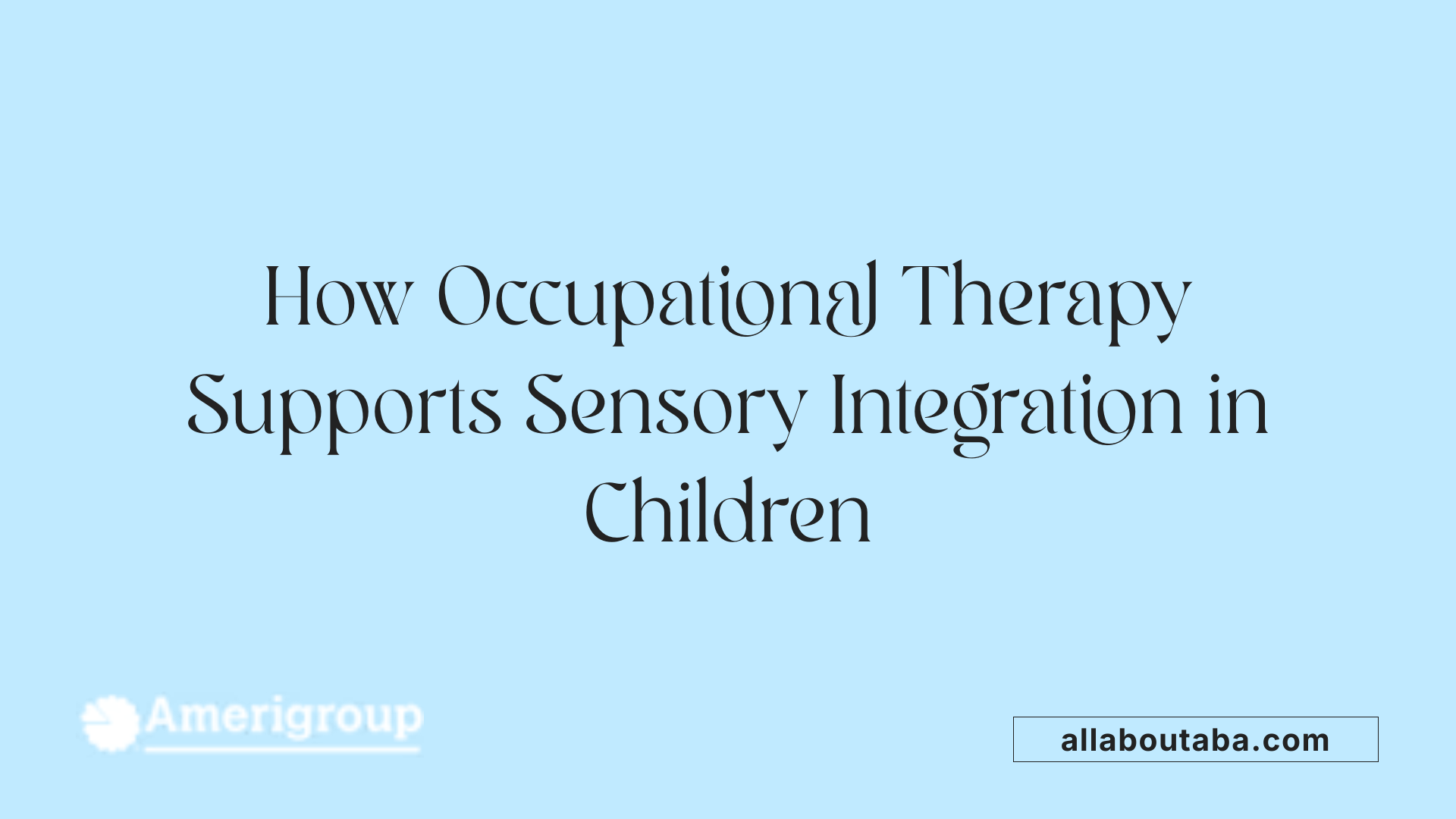Sensory-Based Interventions For Autism At Home
Understanding and Implementing Sensory Interventions at Home
Children with autism often experience sensory processing challenges that can interfere with daily activities and emotional regulation. Effective sensory-based interventions, when thoughtfully incorporated into the home environment, can promote better self-regulation, reduce anxiety, and improve overall quality of life. This article explores practical activities, tools, and strategies that caregivers can use to support children’s sensory needs, backed by current research and expert insights.
Practical Activities and Tools for Supporting Sensory Processing in Children with Autism at Home
What are practical activities and tools for supporting sensory processing in children with autism?
Supporting children with autism in managing their sensory experiences requires practical activities and tools that can be easily incorporated into daily routines at home. Sensory bins are a popular choice, providing a contained space filled with materials like rice, beans, or pasta, allowing children to explore various textures safely. These help stimulate tactile and proprioceptive senses.
Creating homemade play dough is another versatile activity. It encourages tactile exploration and fine motor skills while offering calming sensory input. Simple recipes with ingredients like flour, salt, water, and food coloring make it easy to customize textures and colors.
Engaging children in movement activities can be highly beneficial. Games like log roll yoga, obstacle courses, straw races, or balancing exercises stimulate the vestibular and proprioceptive systems. These activities help improve body awareness and provide calming or alerting sensory input based on the child's needs.
Using sensory tools can also make a significant difference. Textured toys, fidget objects, and calming weighted blankets offer comforting sensory input and promote self-regulation. These tools serve as portable options that children can use during moments of overwhelm or when needing focus.
An effective sensory support plan often incorporates a sensory diet—an individualized schedule of sensory activities tailored to the child's specific sensitivities and preferences. Sensory diets can include calming activities like deep pressure or swinging, as well as alerting activities like jumping or bouncing.
Working closely with occupational therapists is crucial to develop personalized strategies and select suitable tools. They can help identify the sensory triggers and craft routines that promote better regulation and engagement.
Overall, employing these practical activities and tools at home can foster improved sensory processing, making daily life more comfortable and enjoyable for children with autism.
Supporting Sensory Processing Challenges in the Home Environment

How can parents support sensory processing challenges in children with autism at home?
Parents play a crucial role in helping children with autism manage their sensory processing difficulties. One effective strategy is creating a space that promotes calmness and predictability. Setting up routines provides structure, reducing anxiety and helping children know what to expect.
Having organized sensory tools within easy reach encourages children to self-activate sensory strategies when needed. Tools such as weighted lap pads, chew toys, or textured objects can meet sensory needs and promote self-regulation.
Adjusting lighting and sound levels also minimizes sensory overload. Using soft lighting, reducing noise, or creating quiet areas helps children stay comfortable in their environment.
Designating a safe zone or calm-down corner provides a dedicated space where children can regulate their emotions and sensory input during overwhelming moments. Filling this area with sensory equipment like wobble cushions, calming visuals, or plush toys can support relaxation.
Implementing a sensory diet tailored to the child's specific needs involves scheduled activities that incorporate proprioceptive, vestibular, and tactile inputs. For example, activities like bouncing on an exercise ball, swinging, water play, or playing with sensory bins can enhance sensory integration.
Supporting emotional well-being is equally important. Techniques such as mindfulness exercises, breathing strategies, or simple relaxation routines help children process their feelings and reduce stress.
By combining these approaches—structured routines, accessible tools, environmental adjustments, safe zones, and personalized sensory activities—parents can create a nurturing environment that fosters sensory regulation and emotional resilience.
Ideas for Giving Sensory Therapy at Home

What are some ideas for giving sensory therapy at home?
Parents and caregivers can incorporate a variety of sensory-based activities into daily routines to support children with sensory processing challenges. Creating sensory bins filled with materials like rice, beans, or water beads provides tactile exploration that stimulates different sensory pathways. These bins are easy to set up and can be tailored to the child's preferences and sensitivities.
Movement activities are especially beneficial in engaging vestibular and proprioceptive systems. Simple options include swinging, jumping on a trampoline, or engaging in yoga poses like the 'logs roll.' These exercises promote balance, coordination, and sensory regulation.
Craft activities rich in sensory input can also be very effective. Homemade play dough, slime, and finger painting involve tactile sensations and visual engagement, helping children explore textures and colors at their own pace.
Calming games that improve focus and coordination include playing hot potato, straw races, or simple obstacle courses. These activities add fun while supporting motor skills and attention.
Finally, soothing techniques such as gentle brushing (like the Wilbarger Protocol), deep pressure massage, or the use of weighted blankets can reduce sensory overload and promote emotional calming. Integrating these activities into routine times offers practical ways to help children self-regulate and feel more comfortable.
By designing personalized sensory experiences and routines, caregivers can create a supportive environment that fosters sensory development and emotional well-being for children with autism.
Effective Sensory-Based Interventions for the Home Setting

What are effective sensory-based interventions that can be implemented at home for children with autism?
Implementing sensory-based strategies at home can significantly help children with autism manage sensory sensitivities and improve their overall regulation. One effective approach is creating dedicated sensory corners or zones within the home. These spaces are equipped with various textures, tactile toys, and calming items that allow children to explore and self-soothe.
Heavy work activities are another practical intervention. These involve pushing, pulling, carrying objects, or engaging in chores like vacuuming and carrying groceries. Such activities provide proprioceptive input, helping children feel grounded and calm.
Vestibular activities stimulate balance and spatial orientation. Simple actions like swinging, jumping on trampoline, or crawling through obstacle courses can provide the vestibular input children need for better regulation.
Deep pressure techniques are widely used to create calming effects. Comforting hugs, weighted blankets, or squeeze toys can give a sense of safety and stability. These inputs promote relaxation and help reduce anxiety or sensory overload.
Incorporating rhythmic and musical activities, like singing, drumming, or music therapy, can also support sensory regulation. Additionally, brushing protocols, where gentle tactile brushing is used, can help children with tactile sensitivities.
Play-based sensory activities are essential because they engage children in enjoyable, meaningful ways while challenging and supporting their sensory processing. These activities should be tailored to meet each child's unique sensory profile.
When designing and implementing these interventions at home, it is beneficial to work with qualified professionals such as occupational therapists. They can offer personalized guidance to adapt strategies safely and effectively, ensuring that each child's needs and preferences are prioritized.
Overall, a combination of sensory corners, heavy work, vestibular stimuli, deep pressure, and engaging play activities can foster better self-regulation and participation in daily routines for children with autism.
Sensory Regulation Strategies for Children with Autism

What are effective sensory regulation strategies for children with autism?
Children with autism often experience sensory processing differences, which can lead to over- or under-responsiveness to stimuli such as sounds, textures, lights, and smells. To help them manage these sensitivities and promote better self-regulation, tailored sensory input is essential.
One key strategy is providing calming activities. These include deep pressure techniques such as weighted blankets or lap pads, which can create a soothing sensation. Vibrating toothbrushes and unflavored toothpaste are also helpful for children resistant to teeth brushing by offering gentle, calming tactile input.
Movement breaks are vital in helping children discharge excess energy or regain focus. Activities like jumping jacks, dance, obstacle courses, and water play can provide vestibular input that stabilizes their sensory system. Using alternative seating, such as wobble cushions, therapy balls, or rocking chairs, encourages movement and helps children stay engaged without feeling overwhelmed.
In addition, creating sensory-friendly spaces at home or in classrooms offers children a refuge from overwhelming stimuli. Filling these areas with sensory tools like noise-canceling headphones, fiddle toys, or sensory charts enables children to self-regulate when needed.
The sensory diet approach is another effective method. It involves designing daily routines that include specific activities aimed at increasing or decreasing arousal levels. For example, incorporating rhythmic music or swinging for calming or vigorous movement for alertness, tailored to each child's unique sensitivities.
Parents, teachers, and occupational therapists should observe children's responses to different inputs and adapt strategies accordingly. Each child's sensory profile might include sensitivity to certain stimuli, preference for specific activities, or need for additional supports. Personalization ensures sensory interventions are effective and promote emotional and behavioral regulation.
In summary, these sensory strategies—ranging from calming activities and movement breaks to sensory tools and personalized sensory diets—are essential in supporting children with autism. Implementing them thoughtfully can improve focus, reduce anxiety, and enhance overall well-being.
The Role of Occupational Therapy and Evidence Supporting Sensory Interventions

What is the role of occupational therapy in sensory interventions for children with autism?
Occupational therapy is central to providing personalized, evidence-based strategies for children with autism who face sensory processing challenges. Therapists assess each child's sensory profile to identify sensitivities or preferences related to sound, touch, movement, visual stimuli, and more.
Based on this assessment, occupational therapists develop tailored sensory plans called sensory diets. These diets include activities and environmental modifications designed to help children regulate their responses to sensory input. Examples include weighted blankets, swing therapy, proprioceptive activities like carrying objects, and movement breaks such as jumping or dancing.
Therapists also use tools such as sensory rooms, tactile toys, and equipment like wobble cushions to create supportive environments. They focus on improving sensory modulation, which helps children better manage over- or under-responsiveness, ultimately enhancing their participation in daily routines.
While research results vary, there is evidence of some positive effects from sensory interventions, especially in improving behavior, attention, and social engagement. However, many studies have methodological limitations, highlighting the importance of personalized, carefully planned interventions.
Overall, occupational therapy helps children better adapt to sensory environments, supporting their development of functional skills and fostering independence across home, school, and community settings.
Evidence and Research on Sensory Interventions for Children with Autism
What are evidence-based sensory interventions for children with autism?
Sensory interventions for children with autism aim to help them manage their responses to sensory stimuli, improving their functionality and social engagement. According to professional guidelines and research, some evidence-supported approaches include sensory integration therapy (SIT), sensory diets, and various sensory processing strategies tailored to each child's unique sensory profile.
Sensory integration therapy involves structured, play-based activities that target hypersensitivity or hyposensitivity to stimuli such as sounds, textures, and lights. These interventions are often conducted by occupational therapists trained specifically in Ayres Sensory Integration and involve creating individualized programs. Despite its popularity, evidence from systematic reviews suggests that the scientific support for SIT in directly reducing core autism symptoms is limited. However, there is moderate evidence indicating benefits in improving motor skills, attention, and adaptive behaviors.
Sensory diets are personalized schedules of sensory activities designed to promote regulation. These may include movement breaks, tactile activities, or calming interventions like weighted blankets or deep-pressure techniques. Such approaches are adaptable for home and school environments and aim to reinforce calming or alerting sensory input based on the child's needs.
Complementary strategies include music therapy, animal-assisted interventions, and environmental modifications, which can have positive effects on social skills, emotional regulation, and overall wellbeing. While these techniques may lack robust scientific validation in large-scale studies, many practitioners and families report improvements in daily functioning.
It is important to emphasize that combining sensory strategies with behavioral and developmental therapies creates a multisystem approach. Personalized treatment plans that consider individual sensory profiles are more likely to yield positive outcomes.
Overall, the evidence advocates for a tailored, flexible use of sensory interventions, implemented by qualified professionals and integrated into broader therapeutic programs. Ongoing research aims to strengthen the scientific foundation for these approaches and clarify their specific impacts on autism symptoms.
Empowering Caregivers with Knowledge and Support
Supporting children with autism through sensory-based interventions at home requires a combination of practical activities, tailored strategies, and ongoing collaboration with professionals. Evidence suggests that personalized sensory diets, environmental adjustments, and engaging, fun sensory activities can significantly improve regulation and reduce sensory overload. The effectiveness of these approaches increases when families are supported with education, guidance, and tools such as sensory tools, safe spaces, and routines. Ultimately, empowering caregivers with knowledge about sensory profiles and intervention techniques builds confidence and fosters an environment where children feel secure, understood, and able to thrive.
References
- Ten simple sensory strategies for autistic children
- Interventions Targeting Sensory Challenges in Children With Autism ...
- Part 2: Sensory-Friendly Strategies for Home
- Sensory-Based Therapies | Kennedy Krieger Institute
- A Systematic Review of Sensory Interventions for Children With Autism
- Treatment and Intervention for Autism Spectrum Disorder - CDC
- 3 Best Sensory Integration Therapies for Kids with Autism
Other articles
Recent articles

Autism And Eating Challenges Beyond Picky Eating

Best Practices For Autism-Friendly Public Transport Design

Best Ways To Foster Collaboration Between Parents And Schools For Autism Support

Supporting Autistic Children During Transitions Between Activities

The Role Of Teachers In Fostering Autism Peer Acceptance

Using Art Therapy To Support Children With Autism

Autism And Strategies For Addressing Sensory Defensiveness

Autism And The Benefits Of Structured Leisure Activities

How To Support Autistic Students During Exam Season

Autism And Goal Setting For Personal Growth

How To Use Gamification In Autism Learning Programs

How Schools Can Reduce Bullying Of Autistic Students

Early Intervention Strategies For Autism Spectrum Disorder

The Role Of Therapists In Autism Life Skills Coaching

How To Support Autistic Individuals In Crisis Situations

Autism And Self-Care Routines For Stress Management

Understanding Echolalia And Its Role In Autism Communication

Autism And Fine Arts Education Benefits

The Impact Of Multisensory Learning On Autism Education

How Family Counseling Supports Autism Household Dynamics

Best Practices For Inclusive Playgrounds For Autism

Best Practices For Autism-Friendly Shopping Centers

How Autism Affects Fine Motor Skill Development

Best Ways To Introduce Sensory Activities Into Daily Routines

How Sports Teams Can Be Inclusive Of Autistic Players

Autism And Strategies For Building Workplace Resilience

Autism And The Impact Of Hormonal Changes During Puberty

How To Support Autistic Students In Foreign Language Classes

Best Ways To Teach Money Skills To Teens With Autism

Supporting Siblings Of Children With Autism

Autism And Co-Occurring Gastrointestinal Disorders

The Role Of Art Projects In Autism Sensory Integration

How Schools Can Incorporate Sensory Break Spaces

Best Practices For Autism Sensory Regulation At School

Autism And Strategies For Teaching Organizational Skills

Understanding The Relationship Between Autism And Anxiety Disorders

Autism And Life Planning For Long-Term Care

Exploring Visual Supports In Autism Education

Ways To Encourage Social Interaction In Children With Autism

The Connection Between Autism And Dyscalculia

The Role Of Occupational Therapy In Transition Planning For Autism

The Role Of Physical Therapists In Autism Motor Skills Support

How To Teach Decision-Making Skills To Autistic Young Adults

The Connection Between Autism And Epilepsy

Best Practices For Transitioning Autistic Children Into New Schools

Autism And Time Management Challenges In Adulthood

The Role Of Visual Arts In Autism Communication Development

How To Address Tactile Defensiveness In Autism

Best Practices For Telehealth Autism Therapy

How To Help Autistic Children Develop Friendship Skills

How Schools Can Support Autistic Students In Career Prep

Best Strategies For Autism-Friendly Event Planning

Understanding Noncontingent Reinforcement In Autism Behavior Plans

How Drama Therapy Benefits Autistic Individuals

Best Practices For Autism-Friendly Fitness And Recreation Centers

Best Ways To Promote Healthy Social Media Use For Autistic Teens

How To Help Autistic Children Cope With Public Speaking

Autism And Strategies For Managing Unexpected Changes

Best Podcasts About Autism For Parents And Educators

Autism And The Impact Of Seasonal Changes On Behavior

The Role Of Diet In Managing Co-Occurring Conditions With Autism

Sleep Challenges In Autism And Practical Solutions

Best Ways To Build Daily Routines For Autistic Children

Best Practices For Supporting Autistic Entrepreneurs

Autism And Strategies For Navigating Large Social Gatherings

Adaptive Sports And Recreational Activities For People With Autism

Autism And The Benefits Of Story-Based Learning Activities

Understanding The Role Of Play In Autism Development

Autism And The Impact Of Environmental Noise On Learning

How To Create Autism-Friendly Community Spaces

Autism And Chronic Health Conditions: What To Know

The Role Of Care Managers In Autism Life Planning

How To Teach Social Boundaries To Autistic Children

How Autistic Individuals Experience Empathy Differently

How To Support Autistic Employees In Remote Work Settings

Autism And The Relationship Between Motor Skills And Learning

How To Create Community Resource Guides For Autism Families

How To Teach Daily Living Skills To Autistic Teens

Autism And The Impact Of Mind-Body Practices On Stress Reduction

Autism And The Benefits Of Outdoor Group Activities

How To Create Autism-Friendly Sensory Paths In Schools

Best Practices For Autism-Friendly Park And Recreation Areas

Autism And Strategies For Reducing School Refusal

Supporting Autistic Individuals In Public Speaking

The Role Of Diet In Managing Autism Symptoms

The Benefits Of Gardening Clubs For Autism Social Development

How To Prepare Autistic Children For Dental Visits

Autism And Employment: Career Paths That Work

Best Practices For Autism-Friendly Hotels And Lodging

The Impact Of Screen Time On Autism Development

Autism Screening Tools For Early Childhood

The Role Of Physical Exercise In Autism Therapy

Best Strategies For Supporting Autistic College Students

The Role Of Technology In Autism Early Detection

Sensory-Friendly Classroom Design Ideas For Autistic Students

The Role Of Speech Therapy In Building Social Communication Skills

Best Strategies For Handling Autistic Burnout In Adults

Autism And The Importance Of Predictability In Routine

Autism And Peer Education: Teaching Acceptance In Schools

Best Practices For Sensory-Friendly Libraries And Reading Rooms
We’re All About You, Your Family, and Your Child

